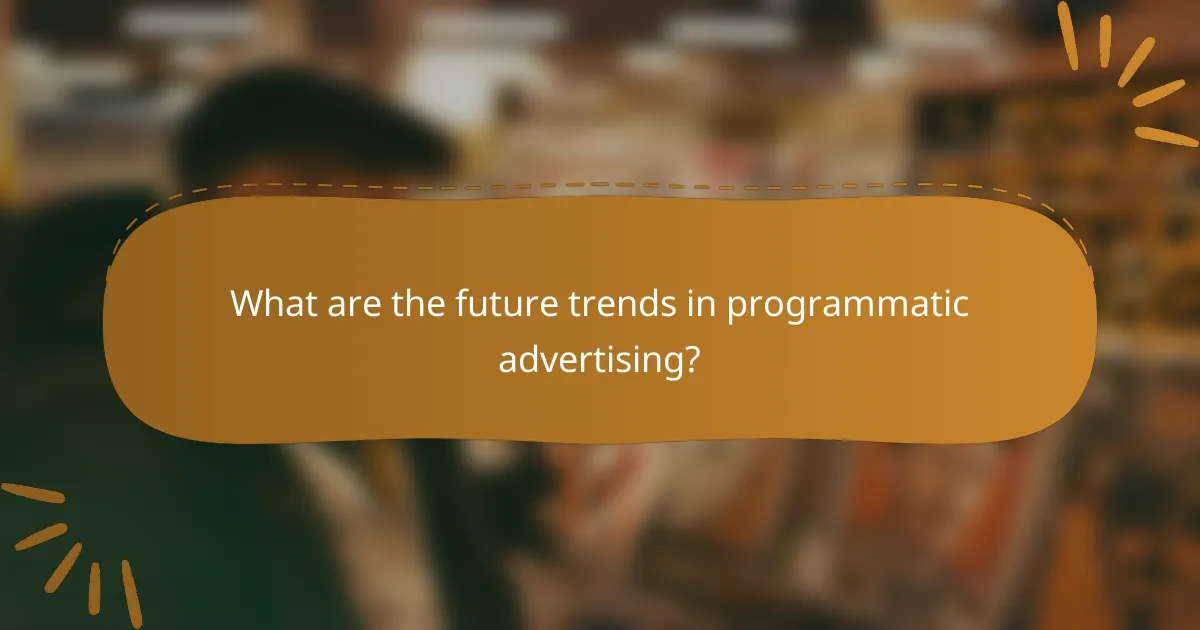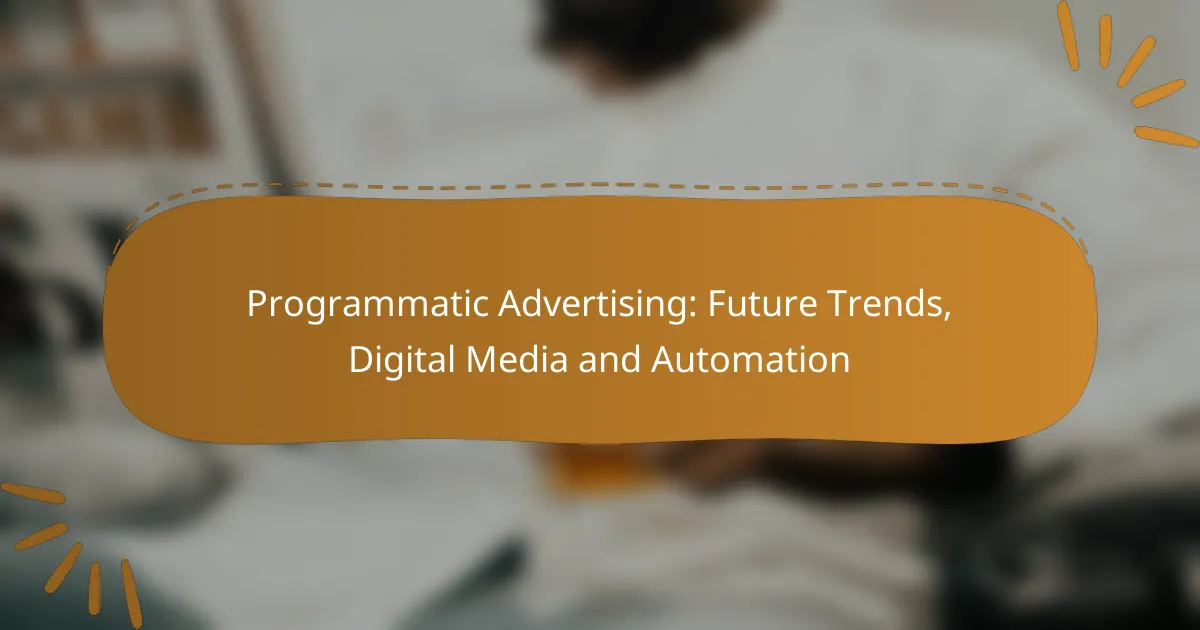The future of programmatic advertising is being transformed by technological advancements and changing consumer behaviors, with a strong emphasis on automation and data privacy. Key trends include the integration of artificial intelligence, the growth of connected TV and audio advertising, and a focus on compliance. These developments enhance efficiency and enable advertisers to optimize campaigns in real time, ensuring precise targeting and improved return on investment.

What are the future trends in programmatic advertising?
The future of programmatic advertising is shaped by advancements in technology, evolving consumer behaviors, and regulatory changes. Key trends include the integration of artificial intelligence, the rise of connected TV advertising, the expansion of programmatic audio buying, and a heightened focus on data privacy and compliance.
Increased use of artificial intelligence
Artificial intelligence (AI) is transforming programmatic advertising by enhancing targeting capabilities and optimizing ad placements. AI algorithms analyze vast amounts of data to predict user behavior, allowing advertisers to deliver personalized content at scale.
For instance, machine learning models can identify patterns in consumer interactions, enabling more effective bidding strategies. Advertisers should consider investing in AI-driven platforms to stay competitive and improve campaign performance.
Growth of connected TV advertising
Connected TV (CTV) advertising is rapidly growing as more consumers shift from traditional television to streaming services. This trend allows advertisers to reach audiences in a more targeted manner, leveraging data from viewers’ online behaviors.
Advertisers should explore CTV platforms that offer programmatic buying options, as this can lead to higher engagement rates. The flexibility of CTV also allows for dynamic ad insertion, making it possible to tailor messages based on real-time viewer data.
Expansion of programmatic audio buying
Programmatic audio buying is gaining traction as digital audio consumption increases. This trend enables advertisers to reach listeners across various platforms, including podcasts and music streaming services, through automated purchasing processes.
Advertisers can benefit from programmatic audio by utilizing data-driven insights to target specific demographics. Investing in audio ad placements can enhance brand visibility and engagement, especially among younger audiences who favor audio content.
Focus on data privacy and compliance
As data privacy concerns grow, programmatic advertising must adapt to comply with regulations such as GDPR in Europe and CCPA in California. Advertisers need to prioritize transparent data practices to build consumer trust and avoid legal repercussions.
Implementing privacy-first strategies, such as obtaining explicit consent for data usage and utilizing anonymized data, is crucial. Staying informed about evolving regulations will help advertisers navigate the complex landscape of data privacy while maintaining effective targeting capabilities.

How is automation transforming digital media buying?
Automation is significantly reshaping digital media buying by streamlining processes and enhancing efficiency. It enables advertisers to make data-driven decisions quickly, optimizing their campaigns in real time.
Real-time bidding efficiency
Real-time bidding (RTB) allows advertisers to purchase ad impressions in milliseconds, ensuring they reach their target audience at the right moment. This efficiency can lead to better ad placements and improved return on investment (ROI).
By leveraging algorithms, advertisers can analyze vast amounts of data to bid on impressions that align with their campaign goals. This process minimizes wasted ad spend and maximizes visibility across digital platforms.
Enhanced targeting capabilities
Automation enhances targeting by utilizing advanced algorithms to analyze user behavior and preferences. Advertisers can segment audiences more accurately, ensuring that ads are shown to individuals most likely to engage.
With tools like machine learning, advertisers can continuously refine their targeting strategies based on real-time data. This leads to higher engagement rates and conversion metrics, as ads are tailored to specific demographics and interests.
Reduction in manual processes
Automation significantly reduces manual processes in digital media buying, freeing up time for marketers to focus on strategy and creativity. Tasks such as ad placement, performance tracking, and reporting can be automated, leading to increased productivity.
By minimizing human intervention, automation also decreases the likelihood of errors, ensuring campaigns run smoothly. Advertisers should implement automation tools that integrate seamlessly with their existing systems for optimal results.

What are the key benefits of programmatic advertising?
Programmatic advertising offers several key benefits, including enhanced efficiency, precise targeting, and improved return on investment (ROI). By leveraging data and automation, advertisers can optimize their campaigns in real-time, ensuring that their messages reach the right audience at the right time.
Improved ROI through data-driven strategies
Data-driven strategies in programmatic advertising allow marketers to analyze performance metrics and adjust campaigns accordingly. This leads to more effective ad spend, often resulting in ROI improvements of 20-50% compared to traditional methods. Utilizing analytics tools helps identify which ads perform best, enabling continuous optimization.
To maximize ROI, focus on key performance indicators (KPIs) such as click-through rates (CTR) and conversion rates. Regularly review these metrics to refine targeting and ad placements, ensuring that budget allocations are directed toward the most effective strategies.
Greater audience reach and segmentation
Programmatic advertising enhances audience reach by utilizing vast data sets to segment users based on behavior, demographics, and interests. This allows advertisers to target niche markets more effectively, increasing the likelihood of engagement. For instance, a campaign targeting young professionals may focus on specific online platforms and content types they frequent.
Employing tools like lookalike audiences can further expand reach by identifying new potential customers who share characteristics with existing high-value clients. This approach not only broadens the audience but also improves the relevance of ads shown to users.
Increased campaign transparency
One of the significant advantages of programmatic advertising is the transparency it offers in campaign performance. Advertisers can access detailed reports on impressions, clicks, and conversions, allowing for better understanding and accountability of ad spend. This transparency fosters trust between advertisers and platforms.
To ensure transparency, choose programmatic platforms that provide clear reporting and insights. Regular audits of ad placements and performance can help identify any discrepancies or areas for improvement, ensuring that campaigns remain effective and aligned with business goals.

What challenges do advertisers face in programmatic advertising?
Advertisers encounter several challenges in programmatic advertising, including ad fraud, technology integration complexities, and evolving data privacy regulations. These issues can hinder campaign effectiveness and impact overall ROI.
Ad fraud and brand safety concerns
Ad fraud poses a significant risk in programmatic advertising, leading to wasted budgets and diminished trust. Common types of fraud include click fraud, impression fraud, and ad stacking, where multiple ads are layered in a single impression.
To mitigate these risks, advertisers should employ verification tools and work with reputable partners. Regular audits and monitoring can help identify suspicious activity and ensure that ads appear in safe environments, safeguarding brand reputation.
Complexity of technology integration
The integration of various technologies in programmatic advertising can be daunting. Advertisers often need to connect multiple platforms, such as demand-side platforms (DSPs), supply-side platforms (SSPs), and data management platforms (DMPs), which may not always communicate seamlessly.
To navigate this complexity, advertisers should prioritize choosing compatible technologies and invest in training for their teams. Simplifying the tech stack and leveraging managed services can also streamline operations and reduce integration headaches.
Data privacy regulations
Data privacy regulations, such as GDPR in Europe and CCPA in California, present challenges for programmatic advertisers. These laws impose strict guidelines on data collection, usage, and consumer consent, impacting how advertisers target audiences.
To comply with these regulations, advertisers must ensure transparency in data practices and obtain explicit consent from users. Implementing robust data governance frameworks and staying updated on regulatory changes are essential steps to avoid penalties and maintain consumer trust.

How to choose the right programmatic advertising platform?
Choosing the right programmatic advertising platform involves evaluating features, integration capabilities, and customer support. A well-suited platform can enhance your advertising efficiency and effectiveness while aligning with your business needs.
Evaluate platform features and capabilities
Start by identifying the essential features your business requires, such as real-time bidding, audience targeting, and analytics. Look for platforms that offer advanced capabilities like machine learning for optimization and cross-channel advertising support.
Consider the user interface and ease of navigation as well. A platform that is intuitive can save time and reduce the learning curve for your team.
Consider integration with existing tools
Ensure that the programmatic advertising platform can seamlessly integrate with your current marketing tools, such as CRM systems and analytics software. This integration is crucial for streamlining workflows and maintaining data consistency.
Check for APIs and compatibility with third-party applications. A platform that works well with your existing infrastructure can enhance your overall marketing strategy and data utilization.
Assess customer support and resources
Evaluate the level of customer support offered by the platform, including availability of live chat, phone support, and comprehensive documentation. Reliable support can be critical, especially during the initial setup and troubleshooting phases.
Look for educational resources, such as webinars, tutorials, and community forums. These resources can help your team maximize the platform’s potential and stay updated on best practices in programmatic advertising.
